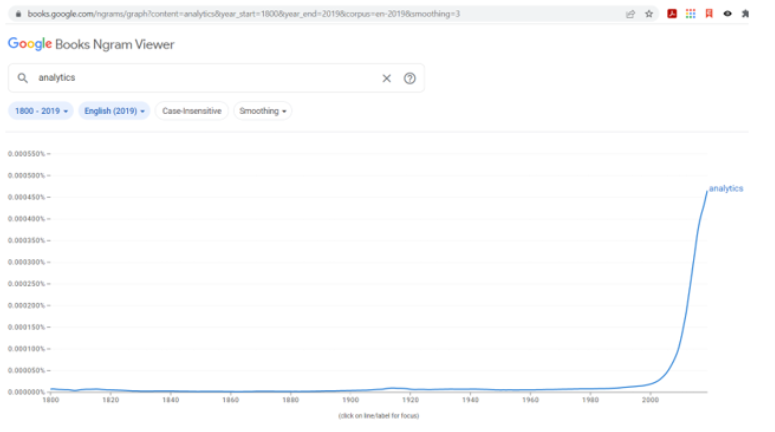1 Defining Business Analytics
Someday soon, say predictive analytics experts, it will be possible for companies to know our tastes and predict our habits better than we know ourselves.
Charles Duhigg
What exactly is business analytics? The business part is easy; it means a commercial operation or a company. Business is often associated with entrepreneurship and management.
Analytics is a little harder—it is the systematic computational analysis of data. So, simply put, it is number crunching. Figure 1.1 shows how the word analytics has exploded in use, according to Google’s Ngram Viewer.

Source: Google Books Ngram Viewer / License.
Before this century, it was not often used, but now analytics is applied to many different fields, such as marketing analytics or baseball analytics. The word analytics is shorthand to indicate the use of quantitative or statistical methods to study something.
Putting the two words together, business analytics is the study of business with a special emphasis on numbers, data, and quantitative information.
More succinctly, business analytics is all about this question:
“What do the numbers say?”
The answer can be approached in three different ways:
- Process
- Explain
- Decide
1. Process: Decode and analyze data to extract information. Most people do this constantly without even realizing it. For example, when reading a menu at a restaurant, the numbers tell you the prices of different dishes, and you can add items together to estimate the total cost of your meal. You would, however, be unlikely to figure out how much revenue the restaurant made from each item if you were handed a stack of receipts for an entire year! A business analyst has specific knowledge of a variety of quantitative methods and skills to crunch the numbers and tell us what the numbers say.
2. Explain: Communicate to others what the data show, such as with data visualization. This time, we focus on interpretation of the data and presenting the data in a way that others can understand. Our role is not that of a CEO (chief executive officer) but that of a CIO (chief information officer). Others will use how we present what the numbers say to make informed decisions.
3. Decide: Make a decision about what to do based on what the numbers say. A business analyst creates models and runs simulations to determine a best option or choice from a variety of alternatives. This is data-driven decision-making. The question becomes, “What do the numbers say to do?”
PED—process, explain, and decide—is what business analysts do. They are comfortable using a variety of technologies and think with numbers. Business analysts are not mathematicians, and they do not necessarily develop software or algorithms; instead, they apply tools and methods to answer business-related questions.
Another way to think about business analytics is by comparing literacy and numeracy. To be literate means you can read and write. It is a continuum; knowing more words increases your literacy. Numeracy is the ability to work with numbers and the mastery of mathematical tools. Business analytics is built on numeracy—we process, explain, and decide with numbers as a foundation and guide.
Business analytics is an interdisciplinary area of study that borrows from mathematics, statistics, computer science, finance, economics, and anywhere else that emphasizes quantitative analysis in the study of business. The borders of business analytics are not well defined, and the field easily blends into other areas, such as data science (which is more aligned with computer science). It can be difficult to pin down exactly what falls under the broad umbrella of this exciting new area, since it accepts input from any source.
A critical, underappreciated aspect of business analytics is ethics. Just because you can do something does not mean you should—no matter how technically sophisticated and impressive. Or, put another way, what the numbers say to do may be the wrong thing to do because it is unethical or immoral. This is worth remembering.
References
The epigraph is from the chapter on Target in Charles Duhigg’s The Power of Habit. Duhigg tells the story of how Target was one of the first retailers to monetize customer data. Target’s success is also an early cautionary tale, as it faced intense backlash when its customers learned that Target somehow knew before family members that someone in the house was pregnant.

